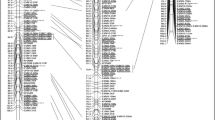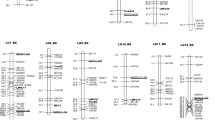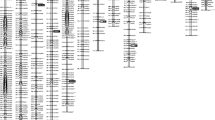Abstract
Framework genetic linkage maps of two progenitor species of cultivated sugarcane, Saccharum officinarum ‘La Striped’ (2n = 80) and S. spontaneum ‘SES 147B’ (2n = 64) were constructed using amplified fragment length polymorphism (AFLP), sequence related amplified polymorphism (SRAP), and target region amplification polymorphism (TRAP) markers. The mapping population was comprised of 100 F1 progeny derived from the interspecific cross. A total of 344 polymorphic markers were generated from the female (S. officinarum) parent, out of which 247 (72%) were single-dose (segregating in a 1:1 ratio) and 33 (9%) were double-dose (segregating in a 3.3:1 ratio) markers. Sixty-four (19%) markers deviated from Mendelian segregation ratios. In the S. spontaneum genome, out of a total of 306 markers, 221 (72%) were single-dose, 43 (14%) were double-dose, and 42 markers (14%) deviated from Mendelian segregation ratios. Linkage maps with Kosambi map distances were constructed using a LOD score ≥5.0 and a recombination threshold of 0.45. In Saccharum officinarum, 146 markers were linked to form 49 linkage groups (LG) spanning 1732 cM whereas, in S. spontaneum, 121 markers were linked to form 45 LG spanning 1491 cM. The estimated genome size of S. officinarum ‘La Striped’ was 2448 cM whereas that of S. spontaneum ‘SES 147B’ was 3232 cM. Based on the two maps, genome coverage was 69% in S. officinarum and 46% in S. spontaneum. The S. officinarum parent ‘La Striped’ behaved like an auto-allopolyploid whereas S. spontaneum ‘SES 147B’ behaved like a true autopolyploid. Although a large disparity exists between the two genomes, the existence of simple duplex markers, which are heterozygous in both parents and segregate 3:1 in the progeny, indicates that pairing and recombination can occur between the two genomes. The study also revealed that, compared with AFLP, the SRAP and TRAP markers appear less effective at generating a large number of genome-wide markers for linkage mapping in sugarcane. However, SRAP and TRAP markers can be useful for QTL mapping because of their ability to target gene-rich regions of the genome, which is a focus of our future research.



Similar content being viewed by others
References
Aitken KS, Jackson PA, McIntyre CL (2005) A combination of AFLP and SSR markers provide extensive map coverage and identification of homo(eo)logous linkage groups in a sugarcane cultivar. Theor Appl Genet 110:789–801
Aitken KS, Jackson PA, McIntyre CL (2007) Construction of genetic linkage map of Saccharum officinarum incorporating both simplex and duplex markers to increase genome coverage. Genome 50:742–756
Al-Janabi SM, Honeycutt RJ, McClelland M, Sobral BWS (1993) A genetic linkage map of Saccharum spontaneum L. ‘SES 208’. Genetics 134:1249–1260
Alwala S, Suman A, Arro JA, Veremis JC, Kimbeng CA (2006a) Target Region Amplification Polymorphism (TRAP) for assessing genetic diversity in sugarcane germplasm collections. Crop Sci 46:448–455
Alwala S, Kimbeng CA, Gravois KA, Bischoff KP (2006b) TRAP, a new tool for sugarcane breeding: comparison with AFLP and coefficient of parentage. Sugar Cane Intern 24:11–21
Barreneche T, Bodenes C, Lexer C, Trontin JF, Fluch S, Streiff R, Plomion C, Roussel G, Steinkellner H, Burg K, Favre JM, Glossl J, Kremer A (1998) A genetic linkage map of Quercus robur L. (pedunculate oak) based on RAPD, SCAR, microsatellite, minisatellite, isozyme and 55 rDNA markers. Theor Appl Genet 97:1090–1103
Berding N, Roach BT (1987) Germplasm, collection, maintenance and use. In: Heinz DJ (ed) Sugarcane improvement through breeding. Elsevier, Amsterdam, pp 143–210
Bhat SR, Gill BS (1985) The implication of 2n egg gametes in nobilisation and breeding of sugarcane. Euphytica 34:377–384
Bishop DT, Cannings C, Skolnick M, Williamson JA (1983) The number of polymorphic clones required to map the human genome. In: Weir BS (ed) Statistical analysis of DNA sequence data. Marcel Dekker, New York, pp 118–200
Bremer G (1961) Problems in breeding and cytology of sugarcane. Euphytica 10:59–78
Cedar H (1988) DNA methylation and gene activity. Cell 53:3–4
D’Hont A, Grivet L, Feldmann P, Rao PS, Berding N, Glazmann JC (1996) Characterisation of the double genome structure of modern sugarcane cultivars (Saccharum spp.) by molecular cytogenetics. Mol Gen Genet 250:405–413
D’Hont A, Ison D, Alix K, Roux C, Glazmann JC (1998) Determination of basic chromosome numbers in the genus Saccharum by physical mapping of ribosomal RNA genes. Genome 41:221–225
da Silva JAG, Sorrells ME, Burnquist W, Tanksley SD (1993) RFLP linkage map and genome analysis of Saccharum spontaneum. Genome 36:782–791
Daniels J, Roach BT (1987) Taxonomy and evolution in sugarcane. In: Heinz DJ (ed) Sugarcane improvement through breeding. Elsevier, Amsterdam, pp 7–84
Daniels J, Smith P, Paton N, Williams CA (1975) The origin of the genus Saccharum. Sugarcane Breed News 36:24–39
Deren CW (1995) Genetic base of U.S. mainland sugarcane. Crop Sci 35:1195–1199
deVicente MC, Tanksley SD (1993) QTL analysis of transgressive segregation in an interspecific tomato cross. Genetics 134:585–596
Dietrich WF, Miller J, Steen R, Merchant MA, Damron Boles D et al (1996) A comprehensive genetic map of the mouse genome. Nature (London) 380:149–152
Edmé SJ, Comstock JC, Miller JD, Tai PYP (2005) Determination of DNA content and genome size in field grown sugarcane interspecific hybrids and genotypes. J Am Soc Sugar Cane Technol 5:1–7
Edmé SJ, Glynn NG, Comstock JC (2006) Genetic segregation of microsatellite markers in Saccharum officinarum and S. spontaneum. Heredity 97:366–375
Ferriol M, Picó B, Nuez F (2003) Genetic diversity of a germplasm collection of Cucurbita pepo using SRAP and AFLP markers. Theor Appl Genet 107:271–282
Frewen BE, Chen THH, Howe GT, Davis J, Rhode A, Boerjan W, Bradshaw HD (2000) Quantitative trait loci and candidate gene mapping of bud set and bud flush in Populus. Genetics 154:837–845
Garcia AAF, Kido EA, Meza AN, Souza HMB, Pinto LR, Pastina MM, Leite CS, da Silva JAG, Ulian EC, Figueira A, Souza AP (2006) Development of an integrated genetic map of a sugarcane (Saccharum spp.) commercial cross, based on a maximum-likelihood approach for estimation of linkage and linkage phases. Theor Appl Genet 112:298–314
Grattapaglia D, Sederoff R (1994) Genetic linkage maps of Eucalyptus grandis and Eucalyptus urophylla using a pseudo-testcross: mapping strategy and RAPD markers. Genetics 137:1121–1137
Guimarães CT, Honeycutt RJ, Sills GR, Sobral BWS (1999) Genetic maps of Saccharum officinarum L. and Saccharum robustum Brandes & Jew. Ex Grassl. Genet Mol Biol 22:125–132
Hoarau JY, Offmann B, D’Hont A, Risterucci AM, Roques D, Glaszmann JC, Grivet L (2001) Genetic dissection of a modern sugarcane cultivar (Saccharum spp.). I. Genome mapping with AFLP markers. Theor Appl Genet 103:84–97
Hu JG, Vick BA (2003) Target region amplification polymorphism: a novel marker technique for plant genotyping. Plant Mol Biol Rep 21:289–294
Hulbert SH, Ilot TW, Egg EJL, Lincolne SE, Lander S, Michelmore RW (1988) Genetic analysis of the fungus Bremia lactucae using restriction fragment length polymorphisms. Genetics 120:947–958
Jackson PA (2005) Breeding for improved sugar content in sugarcane. Field Crops Res 92:277–290
Jannoo N, Grivet L, Seguin M, Paulet F, Domaingue R, Rao PS, Dookun A, D’Hont A, Glazmann JC (1999) Molecular investigation of the genetic base of sugarcane cultivars. Theor Appl Genet 99:171–184
Kubisiak TL, Nelson CD, Nance WL, Stine M (1995) RAPD linkage mapping in a longleaf pine x slash pine F1 family. Theor Appl Genet 90:1119–1127
Kuramoto N, Tomaru N, Murai M, Ohba K (1997) Linkage analysis of isozyme and dwarf loci, and detection of lethal genes in sugi (Cryptomeria japonica D. Don). Breed Sci 47:259–266
Li G, Quiros CF (2001) Sequence related amplified polymorphism (SRAP), a new marker system based on a simple PCR reaction: its application to mapping and gene tagging in Brassica. Theor Appl Genet 103:455–461
Liu ZH, Anderson JA, Hu J, Friesen TL, Rasmussen TL, Faris JD (2005) A wheat intervarietal genetic linkage map based on microsatellite and target region amplified polymorphism markers and its utility for detecting quantitative trait loci. Theor Appl Genet 111:782–794
Maliepaard C, Alston FH, van Arkel G, Brown LM, Chevreau E, Dunemann F, Evans KM, Gardiner S, Guilford P, van Heusden AW, Janse J, Laurens F, Lynn JR, Manganaris AG, den Nijs APM, Periam N, Rikkereink E, Roche P, Ryder C, Sanvasini S, Schmidt H, Tartarini S, Verhaegh JJ, Vrielink-van Ginkel M, King GJ (1998) Aligning male and female linkage maps of apple (Malus pumila Mill.) using multi-allelic markers. Theor Appl Genet 97:60–73
Mather K (1957) The measurement of linkage in heredity. Methuen, London
Mignouna HD, Mank RA, Ellis THN, van den Bosch N, Asiedu R, Ng SYC, Pelemann J (2002a) A genetic linkage map of Guinea yam (Dioscorea rotundata Poir.) based on AFLP markers. Theor Appl Genet 105:716–725
Mignouna HD, Mank RA, Ellis THN, van den Bosch N, Asiedu R, Abang M, Pelemann J et al (2002b) A genetic linkage map of water yam (Dioscorea alata L.) based on AFLP markers and QTL analysis for anthracnose resistance. Theor Appl Genet 105:726–735
Miklas PN, Hu J, Grünwald NJ, Larsen KM (2006) Potential application of TRAP (Targeted Region Amplified Polymorphism) markers for mapping and tagging disease resistance traits in common bean. Crop Sci 46:910–916
Ming R, Liu SC, Lin YR, da Silva JAG, Wilson W, Braga D, van Devnze A, Wenslaff F, Wu KK, Moore PH, Burnquist W, Sorrells ME, Irvine JE, Paterson AH (1998) Detailed alignment of Saccharum and Sorghum chromosomes: comparative organization of closely related diploid and polyploid genomes. Genetics 150:1663–1682
Mudge J, Andersen WR, Kehrer RL, Fairbanks DJ (1996) A RAPD genetic map of Saccharum officinarum. Crop Sci 36:1362–1366
Nikaido AM, Ujino T, Iwata H, Yoshimura K, Yoshimura H, Suyama Y, Murai M, Nagasaka K, Tsumura Y (2000) AFLP and CAPS linkage maps of Cryptomeria japonica. Theor Appl Genet 100:825–831
Panje RR, Babu CN (1960) Studies in Saccharum spontaneum distribution and geographical association of chromosome numbers. Cytologia 25:152–172
Piperidis G, D’Hont A (2001) Chromosome composition analysis of various Saccharum interspecific hybrids by genomic in situ hybridisation (GISH). Int Soc Sugar Cane Technol Cong 11:565
Reffay N, Jackson PA, Aitken KS, Hoarau JY, D’Hont A, Besse P, McIntyre CL (2005) Characterisation of genome regions incorporated from an important wild relative into Australian sugarcane. Mol Breed 15:367–381
Roach BT (1972) Nobilization of sugarcane. Proc Int Soc Sugar Cane Technol 14:206–216
Sreenivasan TV, Ahloowalia BS, Heinz DJ (1987) Cytogenetics. In: Heinz DJ (ed) Sugarcane improvement through breeding. Elsevier, Amsterdam, pp 211–253
Suman A, Kimbeng CA (2007) Molecular diversity among ancestral species of Saccharum and the proportion of diversity represented in major Louisiana commercial breeding clones. ASA Southern Branch 2007 Annual Meeting February 4–6, 2007 Mobile, AL
Tanksley SD, Nelson JC (1996) Advanced backcross QTL analysis: a method for the simultaneous discovery and transfer of valuable QTLs from unadapted germplasm into elite breeding lines. Theor Appl Genet 92:191–203
van Heusden AW, van Ooijen JW, Vrielink-van Ginkel R, Verbeek WHJ, Wietsma WA, Kik C (2000) A genetic map of an interspecific cross in Allium based on amplified fragment length polymorphism (AFLP™) markers. Theor Appl Genet 100:118–126
van Ooijen JW, Voorrips RE (2001) Joinmap 3.0. Software for the calculation of genetic linkage maps. Plant Research International, Wageningen, The Netherlands
Vos P, Hogers R, Bleeker M, Reijan M, van de Lee T, Hornes M, Freijters A, Pot J, Peleman J, Kuiper M, Zabeau M (1995) AFLP: a new technique for DNA fingerprinting. Nucl Acid Res 23:4407–4414
Wu KK, Burnquist W, Sorrells ME, Tew TL, Moore PH, Tanksley SD (1992) The detection and estimation of linkage in polyploids using single-dose restriction fragments. Theor Appl Genet 83:294–300
Young WP, Schupp JM, Keim P (1999) DNA methylation and AFLP marker distribution in the soybean genome. Theor Appl Genet 99:785–792
Acknowledgements
Several staff at the USDA-ARS-SRRC Sugarcane Research Laboratory, Houma, Louisiana, provided technical assistance. The anonymous reviewers provided critical comments and suggestions that helped improve the final version of the manuscript. Funding for this work was partly provided by The American Sugar Cane League of the U.S.A., Inc., and a Louisiana State University Graduate School Fellowship awarded to Sreedhar Alwala. All are gratefully acknowledged.
Author information
Authors and Affiliations
Corresponding author
Rights and permissions
About this article
Cite this article
Alwala, S., Kimbeng, C.A., Veremis, J.C. et al. Linkage mapping and genome analysis in a Saccharum interspecific cross using AFLP, SRAP and TRAP markers. Euphytica 164, 37–51 (2008). https://doi.org/10.1007/s10681-007-9634-9
Received:
Accepted:
Published:
Issue Date:
DOI: https://doi.org/10.1007/s10681-007-9634-9




